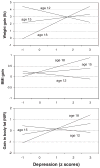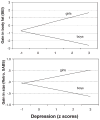The relation of weight change to depressive symptoms in adolescence
- PMID: 20102656
- PMCID: PMC4119807
- DOI: 10.1017/S0954579409990356
The relation of weight change to depressive symptoms in adolescence
Abstract
The Diagnostic and Statistical Manual of Mental Disorders lists weight gain or weight loss as a symptom of depression at all ages, but no study of adolescent depression has examined its relation to actual (not just self-reported) weight change. In the current longitudinal study, 215 adolescents provided physical and self-report measures of change in weight, body mass, and body fat over a 4-month time interval. They also completed psychological measures of body dissatisfaction, problematic eating attitudes, and depressive symptoms. The relation between physical measures of weight change and depressive symptoms varied with age. These relations were explained by individual differences in body dissatisfaction, eating attitudes, and behaviors, leading to questions about weight change as a symptom of depression in adolescence.
Figures


Similar articles
-
Body dissatisfaction, dietary restraint, depression, and weight status in adolescents.J Sch Health. 2010 Apr;80(4):186-92. doi: 10.1111/j.1746-1561.2009.00485.x. J Sch Health. 2010. PMID: 20433644
-
The relative importance of dissatisfaction, overvaluation and preoccupation with weight and shape for predicting onset of disordered eating behaviors and depressive symptoms over 15 years.Int J Eat Disord. 2018 Oct;51(10):1168-1175. doi: 10.1002/eat.22936. Epub 2018 Sep 7. Int J Eat Disord. 2018. PMID: 30194690 Free PMC article.
-
Weight gain attitudes among pregnant adolescents.J Adolesc Health. 1993 Jul;14(5):369-72. doi: 10.1016/s1054-139x(08)80009-2. J Adolesc Health. 1993. PMID: 8399248
-
Weight change and appetite disturbance as symptoms of adolescent depression: toward an integrative biopsychosocial model.Clin Psychol Rev. 2009 Apr;29(3):260-73. doi: 10.1016/j.cpr.2009.01.007. Epub 2009 Feb 10. Clin Psychol Rev. 2009. PMID: 19250729 Review.
-
Determinants of eating attitudes among overweight and non-overweight adolescents.J Adolesc Health. 2007 Aug;41(2):138-45. doi: 10.1016/j.jadohealth.2007.03.007. J Adolesc Health. 2007. PMID: 17659217
Cited by
-
Weight changes and the incidence of depressive symptom in the middle-aged and older adults: findings from the Chinese nationwide cohort study.BMC Public Health. 2022 Dec 6;22(1):2282. doi: 10.1186/s12889-022-14624-5. BMC Public Health. 2022. PMID: 36474202 Free PMC article.
-
Sex Differences in Diet and Physical Activity Behaviors Among Racial/Ethnic Minority Adolescents with High Metabolic Risk.J Racial Ethn Health Disparities. 2025 Feb;12(1):384-394. doi: 10.1007/s40615-023-01880-3. Epub 2023 Dec 22. J Racial Ethn Health Disparities. 2025. PMID: 38135863 Free PMC article.
-
Are increased weight and appetite useful indicators of depression in children and adolescents?J Abnorm Psychol. 2012 Nov;121(4):838-51. doi: 10.1037/a0028175. Epub 2012 Jun 11. J Abnorm Psychol. 2012. PMID: 22686866 Free PMC article.
-
Trajectories of overweight and their association with adolescent depressive symptoms.Health Psychol. 2015 Oct;34(10):1004-12. doi: 10.1037/hea0000201. Epub 2015 Jan 19. Health Psychol. 2015. PMID: 25603419 Free PMC article.
-
Environmental Enrichment and Physical Exercise Attenuate the Depressive-Like Effects Induced by Social Isolation Stress in Rats.Front Pharmacol. 2020 May 29;11:804. doi: 10.3389/fphar.2020.00804. eCollection 2020. Front Pharmacol. 2020. PMID: 32547399 Free PMC article.
References
-
- Abraham S, Luscombe G, Boyd C, Olesen I. Predictors of the accuracy of self-reported height and weight in adolescent female school students. International Journal of Eating Disorders. 2004;36:76–82. - PubMed
-
- Adam CL, Moar KM, Logie TJ, Ross AW, Barrett P, Morgan PJ, et al. Photoperiod regulates growth, puberty and hypothalamic neuropeptide and receptor gene expression in female siberian hamsters 1. Endocrinology. 2000;141:4349–4356. - PubMed
-
- Ahmed ML, Ong KKL, Morrell DJ, Cox L, Drayer N, Perry L, et al. Longitudinal study of leptin concentrations during puberty: Sex differences and relationship to changes in body composition 1. Journal of Clinical Endocrinology and Metabolism. 1999;84:899–905. - PubMed
-
- Ambrosi-Randic N. Perception of current and ideal body size in preschool age children. Perceptual and Motor Skills. 2000;90:885–889. - PubMed
-
- Ambrosi-Randic N, Pokrajac-Bulian A, Taksic V. Nine, seven, five or three: How many figures do we need for assessing body image? Perceptual and Motor Skills. 2005;100:488–492. - PubMed

